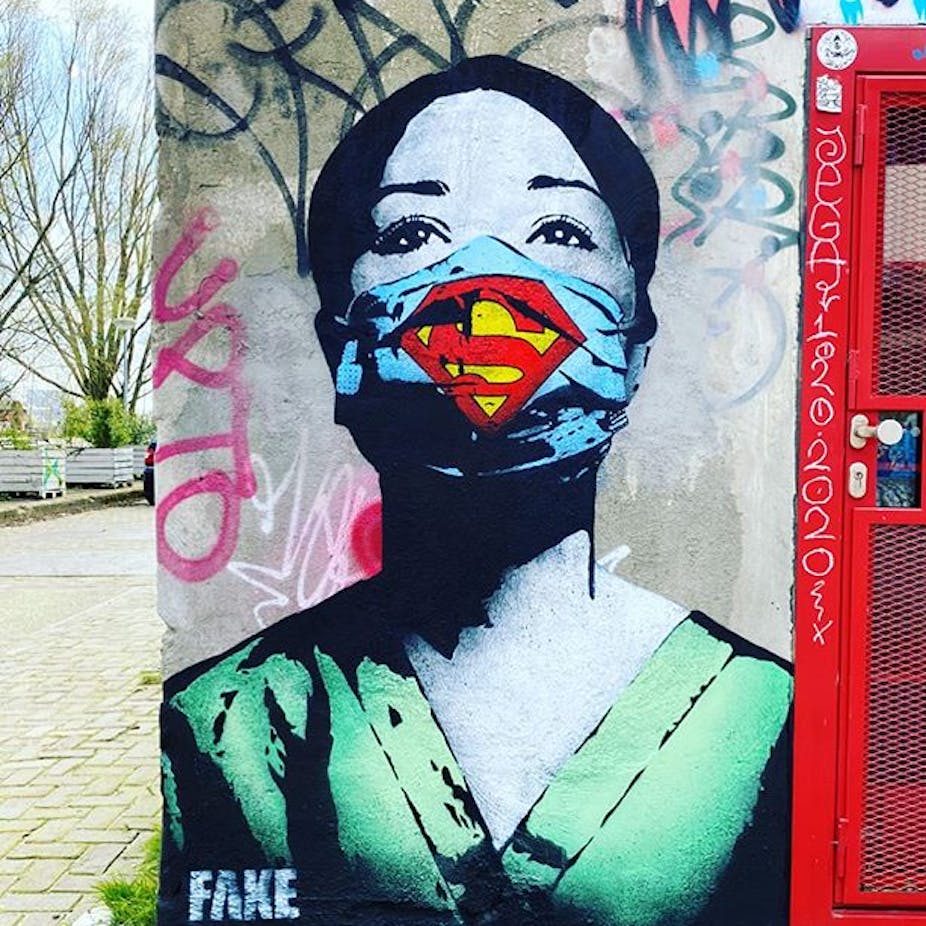There is no aspect of life the COVID-19 pandemic has not affected – and many of us are finding that cultural events and art online are lacking something vibrant and “real”.
One notable exception is street artists and graffiti artists, who have been busy incorporating COVID-19 into their work. The most prominent of these pieces is Banksy’s homage to the NHS and nurses everywhere called “Game Changer”. It hangs in Southampton Hospital, and will eventually be auctioned off for the NHS.
Street artists all over the world have ventured out into quiet streets and left behind vibrant, thought-provoking, amusing commentary on the crisis. Many echo the same message as Banksy, that it’s the nurses and front-line healthcare workers that are the real heroes in this crisis. This can be seen in the new work of Amsterdam-based street artist FAKE, whose mural “Super Nurse!” in the lead image shows a nurse wearing a face mask emblazoned with the Superman logo.
Others are more critical of politicians; or comically cynical about panic buying, social isolation and the pandemic itself. Below is Bristol-based street artist John D’oh’s take on the idiotic and dangerous statement US President Trump made about injecting disinfectant as a potential solution to a COVID-19 infection.
In a similar vein, Brazilian street artist Aira Ocrespo has depicted Brazilian President Jair Bolsonaro. Bolsonaro has discouraged social distancing and lockdown, and was quoted as saying “So what? What do you want me to do?” when asked about Brazil’s rapid increase in COVID-19 cases. The text reads “Bolsonaro’s mask against the coronavirus”.
In another example, Australian street artist LUSHSUX shows Chinese president Xi Jinping wearing a hazmat suit while saying, “Nothing to see. Carry on”. It alludes to the fact that China claimed to have very low COVID-19 infection rates while reports suggest the actual rate may actually be four times higher than stated.
The panic buying that afflicted many communities in the early days of lockdown has also been lampooned. Dominican street artist Jesus Cruz Artiles, aka EME Freethinker, comments on the toilet paper hoarding. Gollum of Lord of the Rings fame is seen uttering his famous line “my precious” while ogling a roll of toilet paper.
John D'oh also gives his take on the toilet roll situation:
Clearly these artists are a reflective group with informed opinions about the social issues around them. And they are not – as some would argue – simply out to vandalise to glorify themselves.
Collective boundaries
Street artists often take news stories, rumours and public information and reflect and exaggerate them. Street art is therefore often a product of the mainstream media, and an integrated component of it. This is commentary that becomes part of the spectrum of opinions about the pandemic.
But these opinions are not subject to any editorial control, nor do they ask for any authoritative permission to be expressed. This allows street artists to say things that might otherwise be excluded from public commentary.
This type of commentary is very important, as it helps society identify where the collective boundaries of acceptable opinion are. Street art that goes too far will be reviled and painted over. But where street art says something compellingly controversial in a creative way, it will be discussed and shared through pictures and social media. This helps the art and the underlying opinions to be more widely accepted.
Carnival against power
Street art painted during the global lockdown is also important as it creates a sense of the carnivalesque. This is a concept put forth by philosopher Mikhail Bakhtin in which social rules and hierarchies are discarded so that a playful but critical critique of society’s structures can be made.
It occurs when the normal rules of society are suspended. Such instances encourage people to actively engage with their experiences so they may identify the artificial barriers and statuses that separate people from each other. It’s hoped that upon seeing these false hierarchies, people reject them and live a more free and unified form of social existence.
Knowing that in some instances, these artists violated lockdown and possibly the law to paint, shows that momentary subversions of authoritative rules are possible, and that the walls of a city can be re-purposed as spaces of expression and commentary.
By mocking political leaders, laughing at the lesser aspects of our humanity, and recognising healthcare workers as superior to the heroes we traditionally mythologise, these murals offer us momentary respite from the constant news barrage and psychological weight of the global COVID-19 crisis.
These artists help to express our collective rage, fear and frustrations, and in doing so they may help us to reduce those feelings just a little. They also express our collective hope and reverence – and just maybe they help increase the unity between us all a little bit more.


